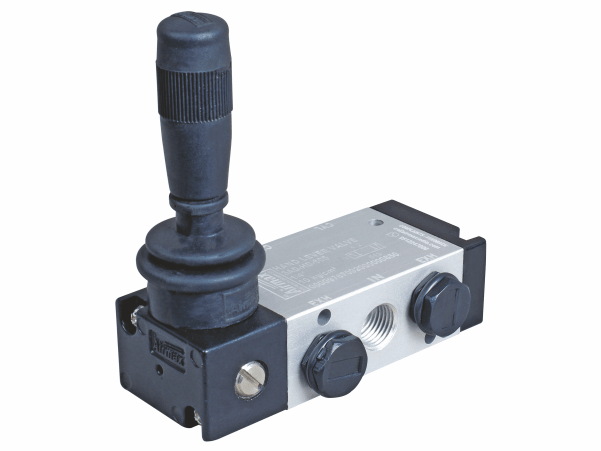Future Trends and Innovations in Hand Lever Valve Technology
Posted by Airmax Pneumatics on May 25th, 2023
The hand lever valve technology field is continuously evolving, driven by advancements in engineering, materials, and automation. As industries become increasingly sophisticated and demanding, the need for more efficient, reliable, and versatile hand lever valves has led to exciting future trends and innovations. This article provides an overview of the upcoming hand lever valve technology developments.
Key points to be covered:
-
Integration of IoT and Automation: Hand lever valves are poised to become smarter and more connected by integrating the Internet of Things (IoT) and automation technologies. This advancement allows for remote monitoring, control, and data collection, enabling better decision-making and predictive maintenance.
-
Enhanced Durability and Longevity: Manufacturers are investing in research and development to enhance the durability and longevity of hand lever valves. Advanced materials and coatings are being employed to improve resistance to wear, corrosion, and extreme operating conditions.
-
Miniaturization and Compact Design: With space being a valuable resource in many applications, there is a growing trend towards miniaturization and compact design of hand lever valves. These smaller valves provide more installation flexibility, especially in tight spaces, without compromising performance.
-
Ergonomic Designs: Manufacturers focus on ergonomic designs prioritizing user-friendliness and comfortable operation of hand lever valves. This includes features such as improved grip, reduced operating force, and intuitive positioning of levers for enhanced user experience.
-
Self-Monitoring and Predictive Maintenance: Hand lever valves with self-monitoring sensors and diagnostic capabilities will enable predictive maintenance. These valves can detect abnormalities, alert operators of potential issues, and schedule maintenance before failures occur, increasing system reliability and reducing downtime.
-
Integration with Robotics and Artificial Intelligence: Integrating hand lever valves with robotics and artificial intelligence technologies opens up new possibilities for automation and optimization. These advanced systems can analyze data, adapt to changing conditions, and make real-time adjustments for improved efficiency.
In conclusion, the future of hand lever valve technology is exciting, with numerous advancements on the horizon. Integrating IoT, automation, advanced materials, miniaturization, and digitalization will revolutionize how hand lever valves are used and controlled. These innovations will increase efficiency, reliability, and sustainability in various industrial applications. As industries embrace these future trends, hand lever valves will continue to play a crucial role in fluid control systems.
Smart Hand Lever Valves: Integration of IoT and Automation
In recent years, integrating the Internet of Things (IoT) and automation technologies has revolutionized various industries, and valve technology is no exception. The emergence of smart hand lever valves has paved the way for increased efficiency, improved control, and enhanced performance in industrial applications. By combining IoT capabilities with traditional hand lever valve designs, these innovative devices offer many benefits that optimize operations and streamline processes.
Here are some key points highlighting the advantages and features of smart hand lever valves:
-
Connectivity: Smart hand lever valves leverage IoT connectivity to establish seamless communication between the valve and other components within a system. This enables real-time data monitoring, remote control, and integration with larger automation networks.
-
Remote Access and Control: With the integration of IoT, operators can remotely access and control hand lever valves from any location using a computer or mobile device. This capability allows for easy adjustments, monitoring, and troubleshooting, reducing the need for physical presence.
-
Data Analytics and Insights: Smart hand lever valves collect and analyze data regarding valve performance, operating conditions, and maintenance needs. These insights help operators identify patterns, detect anomalies, and optimize valve settings for improved efficiency and reliability.
In conclusion, integrating IoT and automation technologies has transformed hand lever valves into intelligent, connected devices. Smart hand lever valves offer benefits such as remote access, data analytics, predictive maintenance, and integration with automation systems. These advancements optimize operations, improve control, and enhance the overall performance of industrial systems. With the rise of smart technologies, the future of hand lever valves looks promising, providing greater efficiency and reliability in various applications.

Enhanced Durability and Longevity: Materials and Coatings
When it comes to hand lever valve technology, one crucial aspect that manufacturers and engineers are constantly striving to improve is the durability and longevity of these valves. The goal is to ensure that hand lever valves can withstand demanding operating conditions and provide reliable performance over an extended period. This drive for enhanced durability and longevity has led to significant advancements in materials and coatings to construct hand lever valves. Here are some key points to consider:
-
High-performance materials: Manufacturers are exploring the use of advanced materials that offer superior strength and resistance to corrosion and wear. Materials such as stainless steel, brass, and reinforced polymers are commonly employed to enhance the durability of hand lever valves.
-
Corrosion-resistant coatings: Applying specialized coatings to the surfaces of hand lever valves can significantly improve their corrosion resistance. Coatings such as electroless nickel plating, ceramic coatings, and polymer-based coatings act as a barrier against corrosive agents, extending the lifespan of the valves.
-
Abrasion and impact resistance: Hand lever valves often operate in harsh environments where they may be subject to abrasion and impact. Innovations in materials and coatings aim to enhance the valves' ability to withstand these conditions. Hardened surfaces, composite materials, and impact-resistant coatings are being used to improve their resistance to wear and damage.
-
Sealing technologies: Proper sealing is crucial for the longevity of hand lever valves. Advancements in sealing materials, such as elastomers and specialized gaskets, ensure tight and reliable sealing even under challenging conditions, preventing leakage and enhancing the valves' durability.
By incorporating these advancements in materials and coatings, hand lever valve manufacturers can offer more robust, reliable, and long-lasting products. These innovations minimize maintenance requirements, reduce downtime, and enhance overall operational efficiency.
Miniaturization and Compact Design: Space-saving Solutions
The trend towards miniaturization and compact design has gained significant traction in the ever-evolving engineering and industrial applications. This trend is also making its way into hand lever valve technology, where space-saving solutions are becoming increasingly important.
-
Optimized Footprint: Hand lever valve manufacturers focus on reducing their products' overall size. By utilizing advanced engineering techniques and materials, they can minimize the physical footprint of hand lever valves. This enables easier integration into tight spaces and crowded equipment configurations.
-
Weight Reduction: Alongside size reduction, efforts are being made to decrease the weight of hand lever valves. This is particularly important in industries with weight-sensitive applications, such as aerospace and robotics. Lightweight hand lever valves not only save space but also contribute to improved overall system performance and energy efficiency.
-
Improved Efficiency: Miniaturized hand lever valves often incorporate advanced flow control technologies, such as precision machining and optimized internal passages. These innovations improve flow characteristics, reduce pressure losses, and increase overall efficiency.
As the demand for efficient use of space continues to grow, the miniaturization and compact design of hand lever valves will play a crucial role in meeting the needs of various industries. By optimizing footprint, reducing weight, utilizing modular designs, integrating with electronic controls, and enhancing efficiency, hand lever valve manufacturers are paving the way for space-saving solutions that deliver reliable performance in increasingly compact environments.
Energy Efficiency and Sustainability: Green Technologies
There has been a growing emphasis on energy efficiency and sustainability across various industries in recent years. This focus extends to valve technology, including hand lever valves. Manufacturers and researchers are developing innovative solutions to make hand lever valves more energy-efficient and environmentally friendly. Here are some key developments in green technologies related to hand lever valves:
-
Intelligent Actuation: Integrating smart technology and automation in hand lever valves enables precise control and reduces energy wastage. By incorporating sensors and actuators, these valves can adjust their position and flow rate according to real-time demands, optimizing energy consumption.
-
Renewable Energy Integration: Hand lever valves can be crucial in renewable energy systems like solar and wind power. By efficiently controlling the flow of fluids, these valves contribute to effectively utilizing renewable energy sources, ensuring optimal performance and maximizing energy output.
-
Leak Detection and Prevention: Energy efficiency is compromised when valves develop leaks. To address this issue, advanced hand lever valves are equipped with leak detection mechanisms, which help identify and rectify leaks promptly. This feature prevents energy losses and promotes sustainability.
-
Life Cycle Analysis and Design Optimization: Manufacturers are now focusing on the entire lifecycle of hand lever valves, from production to disposal. By conducting a comprehensive lifecycle analysis, they can identify areas for improvement and optimize the design and manufacturing processes to minimize energy consumption and waste generation.
Incorporating these green technologies into hand lever valve design and operation reduces energy usage and contributes to overall sustainability efforts. As industries strive for greater energy efficiency and environmental responsibility, hand lever valves are vital in achieving these goals.
Advanced Control Mechanisms: Precision and Fine-tuning
Hand lever valves have been a fundamental component of fluid control systems for many years. However, recent technological advancements have significantly improved their control mechanisms, allowing for enhanced precision and fine-tuning capabilities. These advancements have revolutionized the functionality and performance of hand lever valves, making them more adaptable and reliable in various industrial applications.
To understand the impact of advanced control mechanisms on hand lever valves, consider the following points:
-
Proportional Control: Traditional hand lever valves usually offer on/off control, limiting the ability to adjust the flow rate or pressure finely. With advanced control mechanisms, hand lever valves can now provide proportional control, allowing for precise regulation of fluid flow or pressure levels.
-
Variable Orifice: Some advanced hand lever valves incorporate variable orifice designs. These valves allow users to adjust the orifice size, thereby altering the flow rate or pressure, providing finer control over the fluid system.
Incorporating these advanced control mechanisms in hand lever valves has significantly expanded their capabilities and versatility. Industries such as manufacturing, process control, and automation can benefit from the precision and fine-tuning offered by these technologies. As a result, hand lever valves are becoming indispensable components in systems that demand high levels of control accuracy and reliability.
Ergonomic Designs: User-Friendly and Comfortable Operation
Ergonomics is crucial in designing efficient and user-friendly products, and hand lever valves are no exception. Manufacturers increasingly focus on developing ergonomic designs for hand lever valves to enhance the overall user experience and ensure comfortable operation. Here are some key aspects of ergonomic designs in hand lever valves:
-
Enhanced Handle Design: Hand lever valves are often operated manually, requiring the user to exert force and manipulate the lever. Ergonomic designs incorporate comfortable grip handles that provide a secure and ergonomic grip, reducing strain and fatigue on the user's hand.
-
Optimal Lever Length and Angle: The length and angle of the lever are carefully considered in ergonomic designs. The lever is designed to be within easy reach, allowing for effortless operation without excessive stretching or bending. This ensures that users can comfortably operate the hand lever valve without putting undue stress on their joints or muscles.
-
Smooth Actuation and Low Friction: Ergonomic hand lever valves are engineered to have smooth actuation with minimal resistance. This means that users can easily move the lever to control the fluid flow without encountering any stiffness or jerky movements. Low friction mechanisms, such as high-quality bearings or bushings, are employed to reduce the effort required for operation.
-
Customizable Options: Manufacturers offer customizable options in ergonomic hand lever valves to cater to diverse user preferences and requirements. This includes adjustable lever positions, handle shapes, and sizes, allowing users to tailor the valve to their needs and preferences.
Ergonomic designs in hand lever valves prioritize user comfort, ease of operation, and safety. By incorporating these ergonomic principles; manufacturers ensure that hand lever valves are intuitive, efficient, and user-friendly, ultimately improving productivity and user satisfaction.



